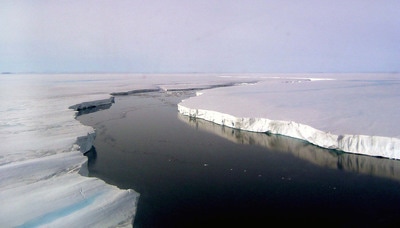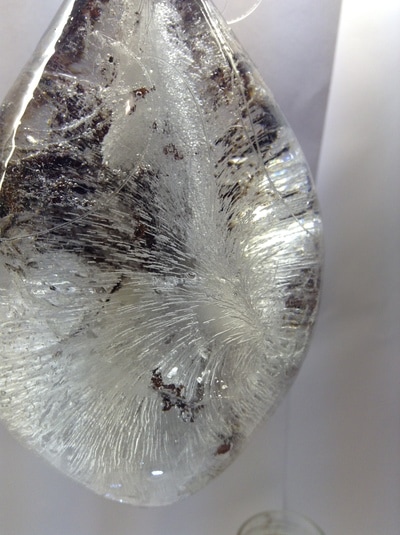 Areas on the earth that or cold enough to change water into solid ice or snow are known as 'Cryosphere's' It derives from the Greek word 'kryos' meaning cold. These regions of our planet have a great influence on the worlds climate. When scientist refer to the cryosphere they mean they are referring to areas where temperatures allow water to freeze into its solid form. These main areas are know as the North Pole; The Arctic & The South Pole; The Antarctic. Both areas are monitored by scientists but the North Pole is covered by a cold ocean where sea ice grows in the winter and shrinks in summer. Frozen ground and permafrost ring the Arctic Ocean. Glaciers, snow, and ice cover the nearby land, including a thick sheet of snow and ice covering Greenland. The Arctic Ocean area is also surrounded by land providing an isolated area that captures the effects of wind and ocean currents from global weather patterns. With these combinations scientist are able to form a real insight into the way this hostile environment is reacting to worldly atmospheric changes. SNOW Snow is precipitation made up of ice crystals. When cold temperatures and high humidity levels combine in the atmosphere, snow crystals form. As long as air temperature remains below freezing, the crystals will fall to the Earth as snow. Snow:
Ice forms when temperatures drop below the freezing point and liquid water becomes a solid, creating a tightly bonded substance. Ice is a key ingredient in glaciers, sea ice, ice shelves, icebergs, and frozen ground. Naturally occurring ice:
SEA ICE Sea ice forms when water in the oceans is cooled to temperatures below freezing. Most sea ice forms in the Arctic and Antarctic Oceans.
GLACIERS Glaciers are thick masses of ice on land. The ice has built up from many seasons of snowfall. Glaciers move downhill very slowly.
Muir Glacier, located in Glacier Bay, Alaska, photographed by W. Field in Aug. 1941 (left) and B. Molnia in Sep. 1976 (middle) and Aug. 2004 (right). Note how the glacier has retreated to expose rock in 1976 that has since become lush vegetation in 2004. The glacier has retreated so much that it is hardly visible in the 2004 photo. —Credit: National Snow and Ice Data Center (comp.). 2002, updated 2009. Glacier Photograph Collection. Boulder, Colorado USA: National Snow and Ice Data Center. ICE SHELVES & ICEBERGS Ice shelves are platforms of ice that form where ice sheets and glaciers move out into the oceans. Ice shelves exist mostly in Antarctica and Greenland, as well as in the Arctic near Canada and Alaska. Icebergs are chunks of ice that break off glaciers and ice shelves and drift in the oceans. Ice shelves and icebergs:
FROZEN GROUND Frozen ground is soil or rock in which part or all of the water has frozen. If the ground is frozen all year long, we call it "permafrost," or permanently frozen ground. Frozen ground:
'The Arctic cold season usually begins in September and ends in March. Monitoring winter sea ice is important to understanding the state of the sea ice. Scientists have found that Arctic sea ice has been recovering less in the winter, meaning the sea ice is already "weak" when the summer melting season arrives. A possible cause is that the underlying ocean is warmer.' (http://nsidc.org/about accessed 17/3/17) The physical materiality of water in its frozen sate within these regions is in a delicate and sensitive position. Within our humbled lives we take for granted the process of freezing and how it enables us to sustain and preserve but fail to recognise the importance of this process as a means to sustain life. The fragility of the freezing process is palpable and gives rise to pure aesthetics of change from solid form to non existence.
0 Comments
The development of my work continues. The intensity of working with ice as a medium and the logistics of how this would be presented in a gallery/exhibition setting is a challenging prospect. My main concerns are the health & safety aspects and worry that when my proposal to exhibit such materials is put forward there will be major issues with the hanging and the collection of melt water in respect of public safety. The pressure for me to develop these forms in such a way where their 'unpredictability' in their melting; their drip positions and the random release of ice from their attachment to the material they hang from i.e. string or monofilament, is difficult. These forms compose of a natural source of unpredictability; they have been formed organically and put together in an organic way. Steps are being made to find the best combinations of materials within these forms and the best appropriate size & consistency in order to get the best solid 'freeze' for maximum melt time. I cannot predict how one of these forms will perform when displayed; they are unpredictable.
-------------------------------------------------------------------------------- A core process of my current practice; the foraging for skeletal leaves and embracing of these beautiful concealed things continues under the surface of my main work. I have recently had some positive feed back from some large needle prick drawing previously made and wonder if things do not work well with the realization of frozen forms that this process may act as a back up for a final piece?????!! It may be an option. My need to realize final work of pure ephemera quality is strong and to visualize aesthetically the fragility of materiality is so well demonstrated through freezing and melt. I will persevere with my fascination in the breath-taking process and drive the project forward! Rebecca Louise Law is a London based installation artist who works with natural materials in order to highlight the environment and its transient nature. Above images show her recent work The Iris which consists of 10,000 fresh blue, purple yellow and white iris suspended with copper wire in a cascade from the ceiling at the NOW Gallery in London. I was drawn to this work initially because of my experience within the flower trade knowing that Iris as a cut flower do not have a long shelf life!
The space has been transformed by the hanging of these flowers; the installation creating an 'interactive exploration of nature' The flowers will wither and die, the flower head will curl, loose its colour, and eventually dry out and go crispy. The transient nature of this is something I am drawn to. The aesthetics of the piece will change within a couple of weeks from being a fresh, spring like spectacle to a cascade of decomposing flowers signifying the cycle of life. From experience the smell created from the 'fresh' flowers will be a burst of green invigorating crispness but as the flowers decompose the smell will turn into a less inviting space to be in. The shadows created from the lighting of this installation all add to the delicateness and transient nature of the piece. The hanging 10,000 Iris also create an added dimension through these shadows; another reflection of the physicality of space, place and presence. Aspects of decay, transience and how a space will change by introducing ephemeral materials need to be taken into consideration if I am to exhibit work that consists of ice as a material. Initial thoughts are that I will suspend pieces but how will this work in an exhibition/gallery setting???!
Here Nene Azevedo installation of small ice figures were documented from start of melt to pools of water to capture the destruction that melt evokes. The figures are installed in public places, they act as an intervention of these spaces. Through the melt the figures become distorted and act as a celebration of the temporary nature of things. The simplicity of the figures combined with their multiples generate a poetic piece that highlights humanity, fragility, memory, the past as well as the future. Where have all these souls gone and where are we going?
http://beautifuldecay.com/2013/12/21/marina-abramovic-seven-artists-make-art-ice/ (accessed 1/3/170
Click to set custom HTML
The above video of her work shows the figures placed in a rural setting, Kendal, Cumbria UK, rather than an urban environment. All the figures are at different stages of melt and sit on stone walls and land. They are like transient beings of the past; present for a short space of time until they evaporate into the atmosphere. The work is very ethereal and conjures a real inquisitiveness from the spectators around them. It is also apparent that these figures are being continuously replenished by individuals to keep the work visual! Something I will need to think about for future showing of ice forms!
http://www.neleazevedo.com.br/pt-videos-monumento-minimo (accessed 2/3/17) Strachen's work has recurring themes of invisibility, displacement (physical & metaphorical) and the idea that both people and matter have a capacity to endure harsh climates and landscapes. He has been using the material of ice and the theme of travel in his work for many years. The above piece consisted of a 4.5 ton block of ice which was harvested from Mount McKinley in Alaska. It was shipped by Federal Express to the contrasting climate of the Bahamas where Strachen originates. It was exhibited in a transparent solar powered freezer at a primary school in Nassau. The layers of fresh and compacted snow and the clear ice formed below bring its original setting to life. The contrasts of environment from its origin and placed within a hot climate is surreal. I wonder how long it would have taken for it to melt?? My question is did he return the block of ice??? Or was it left to melt in another place??? By returning it back to the sea in Nassau this would 'return' it to the place it was taken from in a round about way! If I am to go forward with the showing of ice as a material I have many challenges as regards logistics. How will I transport ice forms to the college? How will I replenish these forms throughout the length of the exhibition, where and how will I collect the melt water??? The transportation by courier is an interesting exercise and something I may need to look into if I am to exhibit ice sculpture! http://beautifuldecay.com/2013/12/21/marina-abramovic-seven-artists-make-art-ice/ (accessed 28/217) The revealing of the above work literally took my breath away. The shear beauty of the frozen particles formed within the ice form are breath-taking. The fragility of this work is demonstrated through its revealing from its contained frozen environment. The melting of the work begins the instant it is revealed. Photography is the only way to preserve its initial aesthetic impact. This piece no longer exists. This transience from a beautiful frozen form to water makes for a poetic reflection of how fragile the elements really are and how as a society we embed ourselves within this precarious state of flux. The documentation off this melt is important and something I know need to tackle.
|
MA Creative Practice
|













 RSS Feed
RSS Feed
